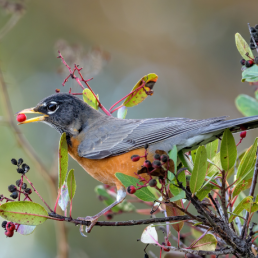

Join BirdNote tomorrow, November 30th!
Illustrator David Sibley and actor H. Jon Benjamin will face off in the bird illustration battle of the century during BirdNote's Year-end Celebration and Auction!
The boreal forest is known as "North America's bird nursery" because more than 300 species of birds breed there, including 80% of the continent's Dark-eyed Juncos. It's also a buffer against climate change. Together, we can preserve the critical habitats of the boreal forest for the benefit of birds and people.

According to Audubon, "The boreal forest — North America’s bird nursery — is one of the largest intact forests left on Earth. Stretching from Alaska to Labrador, it provides nesting grounds and migratory stopovers for nearly half of the common bird species found in North America. Every fall, up to 5 billion birds pour out of the forest and fly south to back yards, parks and wildlands throughout the Western Hemisphere."
But the boreal forest is under pressure. Learn more about boreal birds, the key threats to their survival, and how you can help:
The threat of habitat destruction:
Learn how logging, mining, oil and gas extraction, and hydroelectric development are threatening the boreal forest (Boreal Songbird Initiative).
Consider the ramifications of industrial development (Boreal Science).
Ways to help:
Avoid purchasing paper products (including toilet paper, paper towels and printer paper) that are sourced from unsustainable logging of the boreal forest. Aim for 100% post-consumer recycled material. Check out this toilet paper sustainability scorecard for guidance (Natural Resources Defense Council).
Learn more about successful Indigenous-led conservation models and support them. Sign up for updates through the Pimachiowin Aki World Heritage Site and Thaidene Nëné Indigenous Protected and Conserved Area.
Add your name to the Land Needs Guardians petition and encourage others to join you.

The threat of climate change:
Learn how climate change is likely to affect some boreal birds (Boreal Songbird Initiative).
. . . and how the boreal forest can protect birds from climate change (Audubon)
Ways to help:
Plant more native plants at home and in your community. Audubon makes it easy to find plants for your area.
Report your sightings of boreal birds through eBird. The data you contribute will help scientists better understand bird ranges as our climate changes.
Check out Audubon's Guide to Climate Action.
Reduce your carbon footprint with these tips from Columbia University.

Photo credits:
Dark-eyed Junco © Andrej Chundý CC
Great Gray Owl © Sunny CC
Laughing Gull © Macomb Paynes CC
